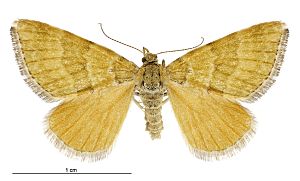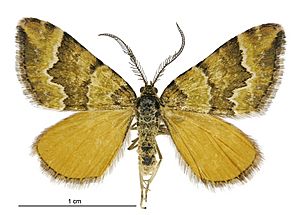Asaphodes cinnabari facts for kids
Quick facts for kids Asaphodes cinnabari |
|
|---|---|
 |
|
| Female | |
 |
|
| Male | |
| Scientific classification | |
| Synonyms | |
|
Asaphodes cinnabari is a species of moth in the family Geometridae. This species is endemic to New Zealand and can be found in Otago and Southland where it lives in alpine swampy habitat.
Contents
Taxonomy
This species was described by George Howes in 1912 as Larentia cinnabari using a specimen collected by himself at Nevis Valley, Central Otago. The species was originally discovered by his brother A. A. Howes at the Garvie Mountains. George Hudson discussed and illustrated this species under the name Xanthorhoe cinnabaris in his 1928 book The Butterflies and Moths of New Zealand. L. B. Prout proposed the subspecies Asaphodes cinnabari obsoleta, however this was synonymised by John S. Dugdale in 1988. In 1971 Dugdale assigned Xanthorhoe cinnabaris to the genus Asaphodes. In 1988 Dugdale used the original description epithet cinnabari in his annotated catalogue of New Zealand lepidoptera. The holotype is held at the Natural History Museum, London.
Description
Howes described the species as follows:
Expanse — in ♂︎, 20 mm. ; in ♀︎, 22 mm. Forewings pale orange, marked with brown and light ochre. Basal area brown, extending to about 1⁄6, where it is edged with a dark line, then a pale-ochreous thin line, which is followed by pale orange to 1⁄3. A dark-brown area from about 1⁄3 to 2⁄3, edged on both sides with a pale-ochre line. This brown area is bent out towards termen at centre of wing, and slightly constricted below. Subterminal line appears as dark shading on costa, and very faintly below. An oblique shaded patch below apex. With the exception of these markings, from 2⁄3 to termen is pale orange. There is a terminal series of small dark dots. Cilia purplish-brown, darker at base. Hind-wings uniform orange, with slight dark dots along termen. Cilia purplish-brown. In the ♀︎ the markings are the same as in the ♂︎ hut the moth is paler. Considerable variation in depth of colouring and extent of the dark markings showed in the specimens taken.
Distribution
This species is endemic to New Zealand. This species is found in Otago and Southland. Along with the type locality, this species has also been collected in locations such as at the Cinnabar Gold Company claim, Greenstone Valley, and Gorge Hill in Mossburn.
Biology and life cycle
The adults of this species is on the wing in November.
Host plants and habitat
The species is an alpine moth and has been collected amongst tussock in swampy habitat. A. cinnabari has been reared in captivity on Hypochaeris radicata.
Threats
The draining and destruction of the swampland habitat this species relies on has led to a decrease in the population of this species in Southland.
Images for kids


